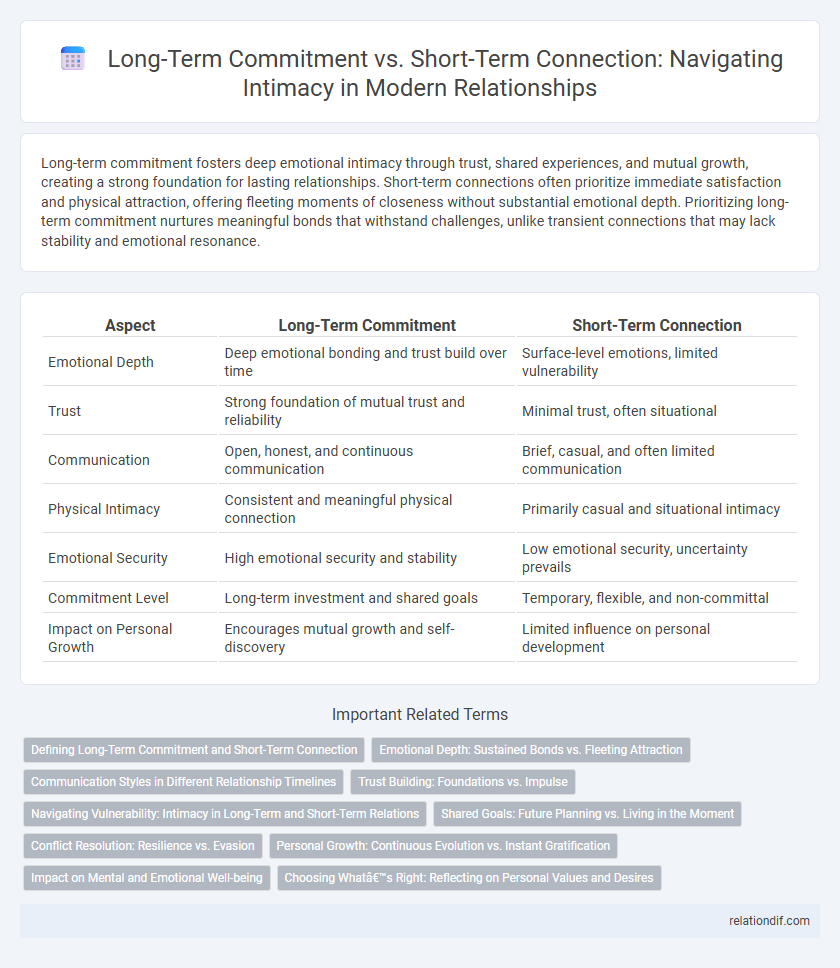Long-term commitment fosters deep emotional intimacy through trust, shared experiences, and mutual growth, creating a strong foundation for lasting relationships. Short-term connections often prioritize immediate satisfaction and physical attraction, offering fleeting moments of closeness without substantial emotional depth. Prioritizing long-term commitment nurtures meaningful bonds that withstand challenges, unlike transient connections that may lack stability and emotional resonance.
Table of Comparison
| Aspect | Long-Term Commitment | Short-Term Connection |
|---|---|---|
| Emotional Depth | Deep emotional bonding and trust build over time | Surface-level emotions, limited vulnerability |
| Trust | Strong foundation of mutual trust and reliability | Minimal trust, often situational |
| Communication | Open, honest, and continuous communication | Brief, casual, and often limited communication |
| Physical Intimacy | Consistent and meaningful physical connection | Primarily casual and situational intimacy |
| Emotional Security | High emotional security and stability | Low emotional security, uncertainty prevails |
| Commitment Level | Long-term investment and shared goals | Temporary, flexible, and non-committal |
| Impact on Personal Growth | Encourages mutual growth and self-discovery | Limited influence on personal development |
Defining Long-Term Commitment and Short-Term Connection
Long-term commitment involves sustained emotional investment, mutual trust, and shared goals that foster deep intimacy over time. Short-term connection emphasizes immediate attraction and transient interactions without the expectation of ongoing responsibility or future planning. Understanding these distinctions clarifies how emotional depth and relational stability differ between enduring partnerships and brief encounters.
Emotional Depth: Sustained Bonds vs. Fleeting Attraction
Long-term commitment fosters emotional depth through sustained bonds that cultivate trust, vulnerability, and mutual understanding over time. Short-term connections often rely on fleeting attraction, emphasizing immediate chemistry rather than profound emotional resonance. Emotional depth in enduring relationships enhances resilience and intimacy beyond the surface level.
Communication Styles in Different Relationship Timelines
Long-term commitment thrives on open, consistent communication characterized by deep emotional sharing and conflict resolution skills, fostering trust and stability. Short-term connections often rely on spontaneous, surface-level exchanges that prioritize excitement and immediate attraction over detailed discussions of values or future plans. Understanding these distinct communication styles helps partners align expectations and navigate relationship timelines effectively.
Trust Building: Foundations vs. Impulse
Trust building in long-term commitments relies on consistent honesty, emotional vulnerability, and shared experiences that deepen bonds over time. Short-term connections often depend on immediate attraction and impulsive decisions, lacking the gradual foundation necessary for enduring trust. Establishing trust through patience and reliability creates a resilient intimacy that withstands challenges beyond fleeting emotions.
Navigating Vulnerability: Intimacy in Long-Term and Short-Term Relations
Navigating vulnerability in long-term commitment requires consistent emotional openness and trust-building, fostering deeper intimacy through shared experiences and resilience. In contrast, short-term connections often prioritize immediate emotional intensity and surface-level disclosure, creating temporary but impactful bonds. Understanding these dynamics enhances the ability to tailor intimacy approaches based on relationship duration and personal boundaries.
Shared Goals: Future Planning vs. Living in the Moment
Long-term commitment in intimacy often centers around shared goals and future planning, fostering stability and mutual growth over time. Short-term connections emphasize living in the moment, prioritizing immediate emotional intensity and spontaneous experiences. Both approaches shape the emotional dynamics and expectations within relationships, influencing satisfaction and personal fulfillment.
Conflict Resolution: Resilience vs. Evasion
Long-term commitment in intimacy fosters resilience through constructive conflict resolution, promoting deeper understanding and trust between partners. Short-term connections often lean towards evasion, avoiding confrontations that hinder emotional growth and connection stability. Building resilience enhances relationship longevity by addressing conflicts openly and learning from challenges.
Personal Growth: Continuous Evolution vs. Instant Gratification
Long-term commitment fosters personal growth by encouraging continuous evolution through shared experiences, deep emotional bonds, and mutual support over time. In contrast, short-term connections often prioritize instant gratification, offering brief moments of pleasure without significant opportunities for self-improvement or emotional development. Embracing long-term intimacy promotes resilience, self-awareness, and evolving understanding within relationships, essential for lasting personal transformation.
Impact on Mental and Emotional Well-being
Long-term commitment fosters a deeper sense of security and emotional stability, significantly enhancing mental well-being through consistent support and trust. Short-term connections often provide excitement and novelty but may contribute to increased stress and emotional volatility due to uncertainty and lack of sustained emotional bonding. Prioritizing long-term intimacy can lead to improved mental health outcomes, including reduced anxiety and greater overall life satisfaction.
Choosing What’s Right: Reflecting on Personal Values and Desires
Long-term commitment often requires aligning with deep personal values such as trust, loyalty, and shared future goals, fostering emotional intimacy through sustained support and growth. Short-term connections emphasize immediate desires like excitement and novelty, focusing on physical attraction and present-moment chemistry. Reflecting on individual priorities helps determine whether emotional depth or transient experiences better fulfill personal intimacy needs.
Long-term commitment vs short-term connection Infographic

 relationdif.com
relationdif.com